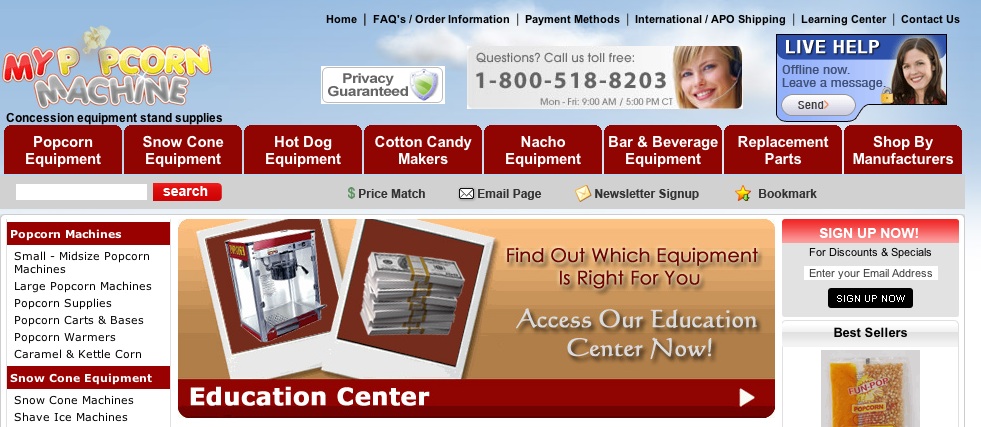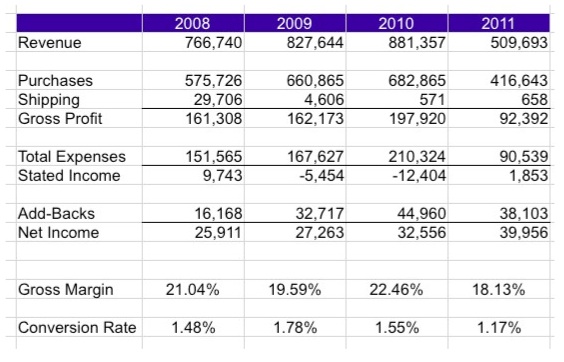
I typically don’t take on eCommerce consulting, but when reader Andy Depperschmidt offered to let me share details of his purchase of a website generating $500,000 in annual revenue, I agreed to advise him at no charge. In this post I’ll be revealing revenue, profitability, traffic stats and the sale price for Andy’s recently purchased site, as well as an overview of the diligence process I performed and advice I gave prior to buying the eCommerce site.
Background
When Andy initially asked for my help, he’d already signed a letter of intent to purchase the eCommerce business and was trying to close the deal within the coming week, so time was short. The time frame and my schedule didn’t allow me to conduct a thorough diligence process, but I did agree to look at the company and give him a better understanding of how to value the eCommerce business for sale.
With limited time, I was most interested in digging into the four areas I thought were most crucial:
- The quality of the site and niche
- Historical financials
- Traffic and the backlink profile
- The fairness of the purchase price
The Site: MyPopcornMachine.com

The site’s owner had recently moved out of the country and was having a hard time managing it from his new home in Hong Kong, so he was selling. By the owner’s admission, the business was not in tip-top shape. He’d done a poor job with customer service the previous two years, and revenues were declining. When I tried to call the 800 number to get a feel for their service, it was disconnected!
Also, for the previous three months he’d completely disabled the shopping cart on the site, because he wasn’t able to process and manage the business while abroad. While the site remained online, customers had consistently been turned away when they tried to purchase.
Between the customer service issues and no-sales period, you could say this was a bit of a fixer-upper and it was being offer for sale at $37,500. Despite these problems, there were a few things I really liked about the site:
Niche Selection: Products like concession equipment have the potential to do well online. They’re hard to find locally yet needed by nearly all schools and sports venues. There’s also the opportunity to sell follow-up items (such as popcorn oil, cleaning kits, etc.) that are required to keep the items running. There were some downsides — and it didn’t meet all the criteria for finding your perfect niche market — but it definitely had potential.
Website Design and Content: I was also surprised by the quality of the website and, in particular, the Education Center that had been created and was prominently advertised on the home page. I’m a huge fan of using educational guides and resources to help drive sales, so I liked that some resources had been considered and created. The site wasn’t perfect, and many of the product pages could use some serious work. But for a site in this price range, it wasn’t too bad.
Financials and Profitability
It’s always fun digging into the financials of a private business, as these usually aren’t shared. For MyPopcornMachine, I condensed some rather long-form financials sheets into this easier-to-read chart:
For those interested in a further breakdown of “total expenses” – which are very high for a drop shipping site of this size – you can download the itemized financial statements here. While I didn’t post a revised copy, I’ll be the first to admit that they could use some re-ordering to provide a more accurate financial picture. For example, a number of card processing fees are listed in ‘Total Expenses” when they really should be included with the product costs to reflect an accurate gross margin. There are also a number of large charges for “customer service” & “website expense” that likely won’t be recurring if Andy operates the business going forward.
Everything else from the financial snapshot above is fairly self-explanatory with the exception of “Add-backs.” Add-backs are historical expenses that a new owner likely wouldn’t incur – or that are largely discretionary – and are added back to the business’ profit. An example would be an expensive conference that the owner attended and expensed to reduce the company’s tax burden, but that wasn’t necessary for running the store.
What stood out most was the dramatic decrease in both revenue and the conversion rate from 2010 to 2011 – largely due to the poor customer service, I’m guessing. Apart from this, I had a few questions/points that I thought Andy should understand before purchasing:
- Where are the credit card processing fees? Most merchants pay 2.5% of revenues to process credit cards, and I didn’t see these in the financials. I’d make sure this isn’t an unexpected expense you’ll incur. (Turns out they’re part of the “Total Expenses” line item above)
- Why did shipping fees drop off in 2009? Did they get baked into the overall COGS (cost of goods sold / purchases) starting in 2009?
- Make sure that the add-backs are legitimate expenses that you wouldn’t normally have incurred. Without them, the store is operating at a loss.
- With 2012 financials not made available to me, make sure you understand how profitability and revenue are trending, and make sure they are similar to 2011.
Traffic, SEO and Backlink Profile
My #1 concern with Andy’s purchase was the quality of the backlink profile and the level of organic traffic from the store. Given the very small margins, it would likely be difficult to profitably run the site while paying for advertising. If the free organic traffic dried up, it could mean the end of the business.
Overall, MyPopcornMachine had some pretty decent traffic stats averaging about 16,000 visitors per month:

That was impressive, but I wanted to know where that came from. Anyone can purchase a boatload of traffic with AdWords, but that doesn’t translate into a profitable business. A quick look into the source of the traffic revealed a pleasant surprise:

I also wanted to see how MyPopcornMachine.com was ranking for some of the main keywords in the niche. It turns out it was ranking on the first page for a number of its primary and secondary keywords:
Solid rankings with organic sources making up nearly 80% of the traffic was a great sign. But it was crucial to examine the backlink profile to determine how that traffic was being generated. If the traffic was the result of a spammy, low-quality SEO campaign, it’s likely that the rankings – and the subsequent traffic – would drop in the near future as Google updates and improves its algorithm.
I headed over to Open Site Explorer and spent some time poring over the backlinks to MyPopcornMachine.com. After some digging, I discovered that most of the links came from directories and off-topic websites – likely the result of a low-level SEO campaign. Though not horrible, the backlink profile was by no means squeaky clean. There were, however, a few authentic links from quality sites linking to the store, which was a positive sign.
This spring, Google released the notorious Penguin algorithm update, which was designed to penalize sites with over-optimized or spammy link profiles. It wreaked havoc on a number of sites, so I was curious to see how MyPopCornMachine fared in late April 2012, when the algorithm update took effect:
Based on traffic trends from the previous years, it looks like the store did suffer a hit to traffic, although it wasn’t as severe as other Penguin penalties I’ve seen. Post-Penguin, the site was still receiving 16,000 visitors per month and ranking well for a number of keywords. So while not immune from future updates, the backlink profile wasn’t deserving of an extreme penalty – a good sign.
With only 34 linking root domains, the existing SEO footprint was fairly small. An investment in a quality white-hat SEO campaign would go a long way to improve the quality of the backlink profile, improve traffic and help decrease the chances of future penalties for the site.
The Purchase Price – Understanding Multiples
With a better understanding of the company’s profitability, I could get an idea of whether the $37,500 being asked was a steal or a rip-off. In the world of business sales, the asking price is most heavily influenced by the company’s profitability, which can be described as “free cash flow,” the “seller’s discretionary earnings” or, for larger businesses, “EBITDA” (Earnings Before Interest and Tax Depreciation and Amortization).
While it has a number of names and variations, the metric represents the cash/profits being generated by the business. A multiple is then usually applied to this figure to come up with a purchase price. Calculating the earnings is the easy part; the difficult part is determining what’s a fair multiple to apply.
The multiple varies significantly based on the size, track record and industry a company is in. Large, publicly traded companies such as Google and Coca-Cola will trade at multiples of 10x or higher, and some high-growth companies like LinkedIn will trade at seemingly crazy multiples of 100x or more.
But for small companies, these multiples will be much, much lower – usually in the 1x to 3x range for small eCommerce stores. Why such a large disparity? Primarily because there’s significantly more risk. While a company like Coke is a pretty sure bet, there are all sorts of risk involved with purchasing a small store like MyPopcornMachine:
- It’s easy for competition to enter the market, especially with drop shipping suppliers
- Google could penalize the site, dramatically hurting revenues
- Disruptions or problems with suppliers/manufacturers could hurt sales
… and many more. Also, because the human cost involved in finding, researching and closing a deal is relatively large compared to the purchase price, the multiple is further decreased.
So is buying an eCommerce business for $37,500, when it makes approximately $40,000 a year, a good deal? With a multiple of less than 1x, it’s definitely on the low end of the pricing scale, even as small eCommerce stores go. The business definitely isn’t perfect, but for less than 1x earnings, I think it’s a fairly reasonable price to pay ASSUMING you’re comfortable taking the risks discussed above.
The Verdict

Here’s what I wrote to Andy to conclude my findings:
——————————————————————————————————————————
In summary, I think that with some marketing efforts and improvement to the website, you could likely increase the revenue and profits of the store. Additionally, while the backlink profile isn’t squeaky clean, it does generate an impressive amount of traffic in a quality niche. You do run the risk of that traffic disappearing in the future due to a mediocre linking history but this could be largely mitigated by doing some quality marketing and SEO of your own.
If you’re trying to decide between buying this site for around 1x annual income and starting your own site from scratch, I think this option would likely offer a better ROI (return on investment) when you consider the amount of time you’d need to invest to build something from scratch AS LONG AS you’re comfortable with the risk involved. Additionally, make sure you consider the time required for customer service and the occasional cost/need for technical help if you’re not comfortable with complex website changes.
——————————————————————————————————————————
After considering advice from both me and his business broker, and performing his own diligence, Andy decided to go through with the sale. He’s now the proud owner of MyPopcornMachine.com and has plans to grow and improve the site. Congratulations, Andy! To help him with these efforts, I’ll be writing a follow-up post discussing recommended changes and improvements to make to MyPopcornMachine.com. Stay tuned.
What Do You Think?

Finally, a big thank you to Andy for being willing to share this information publicly. If you’re in the market for concessions equipment, I hope you’ll check him out!
Photos by Nich Hum, Stephan Baudy and S Falkow.






